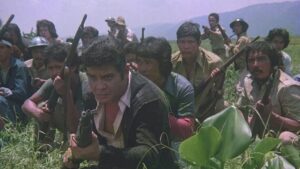Filipino identity in a historical epic

By Brontë H. Lacsamana, Reporter
Movie ReviewAguilaDirected by Eddie Romero
TRUST Eddie Romero to construct big-budget, star-studded historical epics. To follow up the comedic period adventure Ganito Kami Noon… Paano Kayo Ngayon? with the multi-generational tragedy Aguila illustrates a mastery of the film medium that he used to his full advantage.
The latter was apparently very ambitious for its time — it was reported to be the biggest and most expansive Filipino film in 1980, with a budget of P5 million. While in the eyes of a younger generation, it is a product of its time, what with its multiple dramatic subplots and an unwieldy runtime of over three hours, the film delivers an engaging take on Philippine history, traversing the 1890s to the 1970s.
It is fueled by strong performances from the entire cast. Fernando Poe, Jr. (popularly referred to as FPJ) plays the titular character, Daniel Aguila, the 80-plus-year-old patriarch of the family who has been missing for three years. His son, Mari, played by Christopher de Leon, travels to far-flung areas of the country to look for his father. All the while, he is confronted with their family’s long, complex history.
There’s Amalia Fuentes, then way too young and beautiful to be playing FPJ’s mother; Elizabeth Oropesa as the manipulative, sexual character of Lilian; Jay Ilagan as the adopted son Osman; Charo Santos as the strong-willed, intelligent love interest; Eddie Garcia as the evil stepfather Don Simeon; the list goes on.
Given the scope of the story, it’s interesting to see how the events of Filipino history are personally significant to Daniel Aguila. Each character is also well-developed, the narrative fleshed out very thoughtfully to explain every minor storyline. It also explains the film’s length, as the very human, very flawed characters are placed within the complex and tragic history of the Philippines — from the Americans taking over from the Spanish, to the fight against Japanese conquerors, to the rising corruption in the 1970s.
This sprawling tale also marks a unique milestone for FPJ, who took on a surprising dramatic role. Both he and Romero, now National Artists for Film, made Aguila truly special. There was also an unbeatable ensemble behind the camera: Mike De Leon as director of photography, Mel Chionglo as art director, and National Artist for Music Ryan Cayabyab in charge of the score.
The restored film that is screened once in a blue moon these days is thanks to the FPJ Archives, headed by Jeffrey Sonora. At its most recent screening on April 3 at the GSIS Theater, Mr. Sonora said that the original 35-mm film was so damaged that it had been combined with Betacam video footage.
“It took 2,000 hours to process and is still being worked on, until hopefully better technology comes in to further restore the material,” he said.
One can see that the restoration is still a work-in-progress, with grain seen in darkly lit scenes and splotches of color here and there. Other than that, the quality is so clean and clear that it’s intriguing to see how beautiful classic films can be when restored.
Perhaps a downside to the clarity of the visuals is seeing how much room for improvement there was in the make-up department. Back in 1980, there was much controversy over the amount of aging make-up (basically a few lines drawn on their faces) most of the leads needed, since the story takes place over decades. Now we can see why.
Joey Romero, son of the late Eddie Romero, was at the recent screening as well. He marveled at how clean the film looked, with some scenes looking as if they had been shot recently, and dropped a few tidbits about the making of the film, where he served as an assistant director to his father.
The 100th anniversary of Mr. Romero’s birth will be marked this year, which means more of his films will be screened soon. On the wish list of many Romero fans is the epic fantasy film Kamakalawa, known as the third film in his unofficial trilogy exploring the Filipino identity (the first two being Ganito Kami Noon… and Aguila).
In the meantime, Aguila deserves to be seen as much as other, more celebrated films from its time. Aside from its colossal narrative, it’s an awe-inspiring historical document that features nostalgic places across Luzon, Visayas, and Mindanao, carried by a remarkable cast.
Not only is it the biggest film of its time, but it simply has so much to say.




